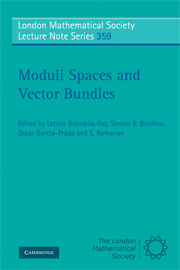Book contents
- Frontmatter
- Contents
- Preface
- Acknowledgments
- Part I Lecture Notes
- Part II Survey Articles
- Part III Research Articles
- 13 Beilinson Type Spectral Sequences on Scrolls
- 14 Coherent Systems on a Nodal Curve
- 15 Brill-Noether Bundles and Coherent Systems on Special Curves
- 16 Higgs Bundles in the Vector Representation
14 - Coherent Systems on a Nodal Curve
Published online by Cambridge University Press: 07 September 2011
- Frontmatter
- Contents
- Preface
- Acknowledgments
- Part I Lecture Notes
- Part II Survey Articles
- Part III Research Articles
- 13 Beilinson Type Spectral Sequences on Scrolls
- 14 Coherent Systems on a Nodal Curve
- 15 Brill-Noether Bundles and Coherent Systems on Special Curves
- 16 Higgs Bundles in the Vector Representation
Summary
Abstract
Let E denote a torsionfree coherent sheaf of rank n, degree d and V ⊂ H0(E) be a subspace of dimension k on a nodal curve X. We show that for k ≤ n the moduli space of coherent systems (E, V) which are stable for sufficiently large values of a real parameter stabilizes. We study the nonemptiness and properties like irreducibility, smoothness, seminormality for this moduli space GL.
Introduction
Coherent systems on smooth curves have been studied and are being studied extensively ([BG], [BOMN], [KN], [LN1], [LN2], [He], to name a few). A brief survey of coherent systems on smooth curves appears in this volume [Br]. In this paper, we initiate the study of coherent systems on a nodal curve. A coherent system on a nodal curve X of arithmetic genus g is a pair (E, V) where E denotes a torsionfree coherent sheaf of rank n, degree d on X and V ⊂ H0(E) is a subspace of dimension k. The (semi) stability condition for coherent systems depends on a real parameter α > 0. It is easy to see that if (E, V) is α-semistable then d ≥ 0. If (E, V) is α-stable, then for k ≥ n one has d > 0 and for k ≥ n one has d > 0 except in case (E, V) = (O, H0(O)).
- Type
- Chapter
- Information
- Moduli Spaces and Vector Bundles , pp. 437 - 455Publisher: Cambridge University PressPrint publication year: 2009
- 3
- Cited by

